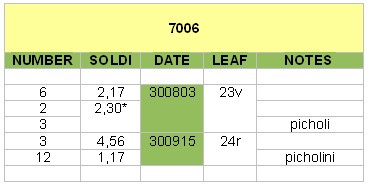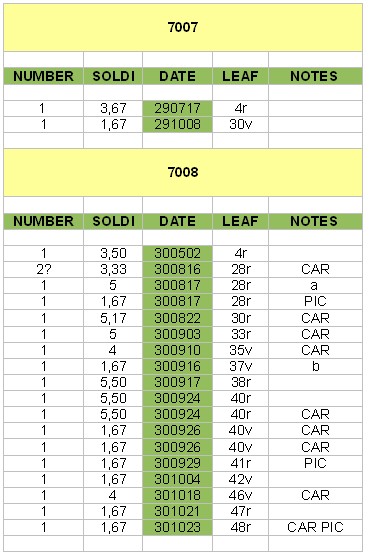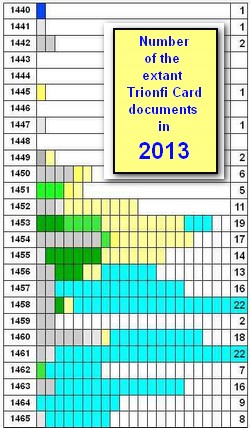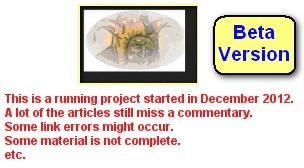Ser Andrea di Giovanni Bertelli in Prato (active 1429 - 1430)
composed by Lothar Teikemeier, last update 06.12.2012
|

Sources
Source is taken from Franco Pratesi's new article series written from November 2011 till now, published here at Trionfi.com.| SOURCE 1: Ser Andrea di Giovanni Bertelli in Prato |
|
Quote from Franco Pratesi: "1430 - NAIBI TRADED IN PRATO BY A NOTARY" , 06.04.2012 |
Ser Andrea di Giovanni BertelliI had never found among mercers or similar retailers a famous personage as Ser Andrea Bertelli was at the time. First of all, he could avail himself of the Ser designation, typical of the notaries. We can find information more than enough about him as a notary and a public man. To begin with, he is present in historical works on Prato citizens,(4) and in a dissertation on the notaries of the town.(5) The shopWhenever I enter one of these shops of the time, I feel a big difficulty in finding the right name for it. Of course, to a great extent this is due to the fact that English is not my mother tongue and moreover I did not have the opportunity to get familiar enough with the corresponding shops in Great Britain. Frankly speaking, however, I have to add that even in my mother tongue I have some difficulty in finding the correct name for them. The account booksNo less than seven account books are kept for the shop under examination.(7) The two most important for us are those numbered as 7007 and 7008. They are very similar and seem to have been compiled one after another, mainly for 1429 the former (10 July-8 December), and 1430 the latter (11 May-24 October). Purchases of naibiI could only find two records of purchases, in book 7006, as summarised in the following Table. 
In the course of about two years, we thus have two purchases, which however corresponded to two subsequent months. My impression is that other purchases had been done, and I did not find their records. Sales of naibiMore frequent are the records of packs sold, as summarised in the following table. If I have read the number of the packs correctly, they were sold one at a time, with one exception in which two packs were sold together. This is in agreement with the typical trade of this shop, with retail sales reduced to very small limits for any goods sold. Sometimes naibi are recorded as carte: I have indicated these cases in the table, but I suppose that the two names were here interchanged without any real difference existing in the product. Also for "naibi picholini" and "carte picholine", I think they are both the same as the "naibi piccoli" of other trades.  We find 21 packs sold on the whole; only two for 1429, with most of the remaining ones sold in only two months of 1430. These can be compared with the 26 packs that we find as acquired, in two trades only. |
|
Repeated Note: When Ross Caldwell and me in 2003 started to collect Trionfi notes between 1442-1463, we had about 27/28 entries (which I nowadays would count as 31). The major part were the documents of Ferrara, which were collected by Gherardo Ortalli and Adriano Franceschini in the "Prince and the Playing Cards" (1996), after the base laying works of Michael Dummett and Stuart Kaplan around 1980. This collection included 2 notes about Trionfi cards in Florence, found by Franco Pratesi in his earlier work (allowances of the Trionfi game in 1450 and 1463). A graphical representation of this time (with 27 entries) shows the dominance of Ferrarese documents (in black) with a few notes only from other locations (in red; see picture to the right) In the period 2004 till October 2011 it was possible to add 4 further notes (Siena 1452, Padova 1455, Ancona c. 1460 and Valerio Marcello c. 1460), mainly thanks to information given by Thierry Depaulis. Franco Pratesi started his new article series in November 2011. Since then the list has gotten 67 new documents till September 2012 (65 of them found by Franco Pratesi, one, now the oldest of September 1440, by Thierry Depaulis, and another one by Veber Gulinelli, who controlled the earlier work of Franceschini and found an overlooked document) and nearly all are related to Florence or its surrounding. A small book (118 pages) was published around Christmas 2012, Franco Pratesi: "Playing Card Trade in 15th Century Florence" as IPCS Paper No. 7 (ISSN 0305-2133). It contains some of the articles, which before had appeared at this website, those, which treat the early time of 15th century. Thierry Depaulis commented in his foreword: "This book is a landmark in the history of early playing cards in Italy". Well, maybe not the book, but the research is clearly a landmark in various interests. For the collection of early Trionfi notes it somehow means, that we have within the year 2012 about 200 % more data for the period 1440-1462 than mankind had collected in the 200 years before. Added later: In August 2013 the new report of Arnold und Doris Esch: "Aus der Frühgeschichte der Spielkarte. Der Import von carte da giocare und trionfi nach Rom." in Gutenberg Jahrbuch 2013, 88. Jahrgang, p. 41-53, arrived in our redaction. It contains 106 new references to Trionfi decks, which all were found in the customs registers of the city Rome for the period 1453-1465. With this the number of all earlier Trionfi cards records has been doubled and should have reached then c. 210 (from which a few are only considered to be "Trionfi card notes" and don't contain the word "Trionfi" or something similar). *********** I'd started to sort the new Trionfi card documents overview in October 2012. Articles will be possibly changed according improvements in research. |
|


